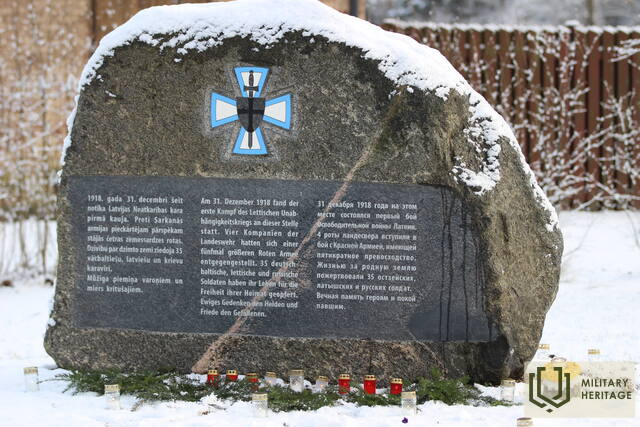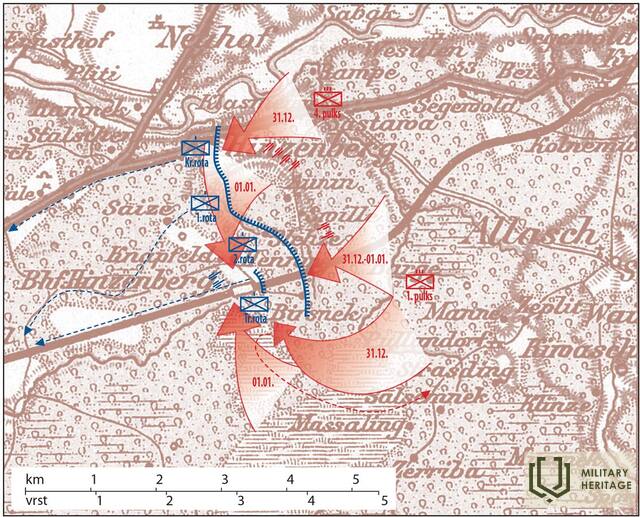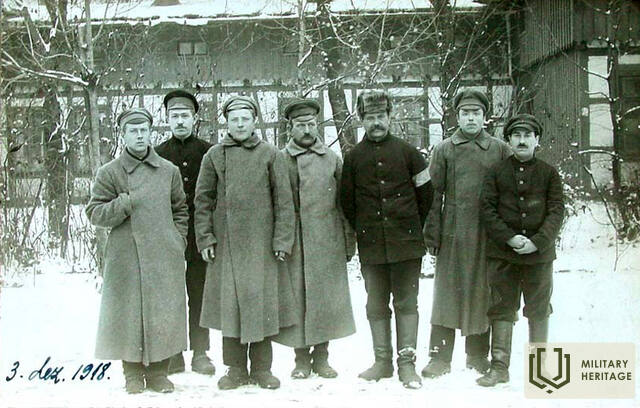Monument to the first battle for Latvia's independence
Memorial site

Atroadas, Inčukalns, Atmodas Street 2.
On July 3, 2016, a monument to the first battle for Latvia's independence, dedicated to the Latvian National Guard (Die Lettländische Landeswehr), was unveiled. sides. Eižens Upmanis, the chairman of the Brothers' Cemetery Committee, concluded at the time that this could be the historically first monument to the combined Latvian and Baltic forces in the battle memorials outside the cemetery. At that time, Lieutenant Colonel Oskars Kalpaks was appointed commander of the Latvian units of the Latvian National Guard or Landesver, from whose units the later Latvian army grew and formed during the Freedom Fights.
In 1918, the entire territory of present-day Latvia had fallen into the hands of the German Empire and its troops. However, at the end of the summer and autumn of 1918, the situation began to end badly for Germany, and it was clear that it was only a matter of time before Germany would be forced to concede defeat in World War I. The Russian Empire, which included Latvia before World War I, had ceased to exist earlier, with the revolutions of February and October 1917. On November 18, 1918, the Republic of Latvia was proclaimed. After the ceasefire with the Entente on November 11, 1918, the German army, which was on the territory of Latvia, was no longer motivated for further warfare, and most of its soldiers simply wanted to return home.
Under such circumstances, it was clear that Latvia's defense depended primarily on the national guard formed by the people of Latvia. Initially, due to their education and relatively greater ability to self-organize, the greatest initiative in creating such a national guard was shown by the Baltic Germans living in Latvia. Russian soldiers also joined the National Guard. In order to ensure the supply of the National Guard with uniforms, weapons and other necessary resources, on December 7, 1918, the Provisional Government of Latvia entered into an agreement with the German representative August Vinnig, providing for the provision of the National Guard from the German army reserves in Latvia. This agreement stated, among other things, that the National Guard, officially known as the Latvian National Guard or in German, the die Lettländische Landeswehr, would be the armed forces of the Republic of Latvia.
Two soldiers of the Latvian Red Rifle Regiment (ie approximately 2,000 to 3,000 soldiers) who had previously experienced in World War I and the Russian Civil War faced the Latvian National Guard. Despite the experience and numerical superiority of the Red Army, the Latvian National Guard held Inčukalns for two days in fierce fighting, until finally, in the evening of January 1, 1919, to avoid siege, was forced to retire, losing 43 dead and several wounded, most of whom was taken captive by the Bolsheviks, where they were killed or died of starvation or disease.
Author: Artis Buks. Material: Boulder. The monument is made of large monolithic stone, which was found in Rolls near Jelgava.
Used sources and references:
https://www.facebook.com/FirstBattleAbout LatviaNeatkaribu/ (viewed: 23.05.2021)














